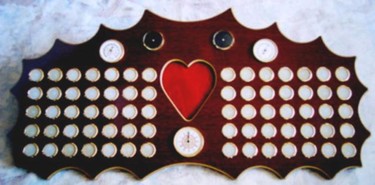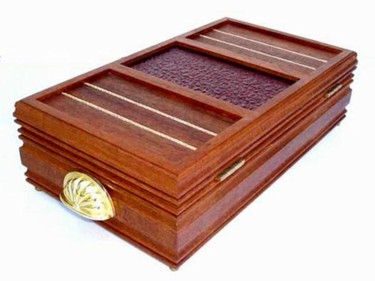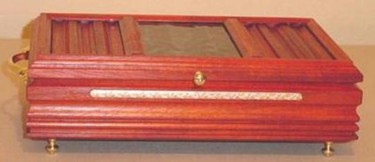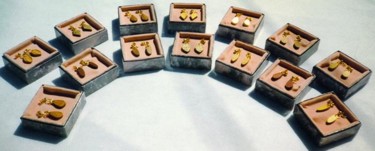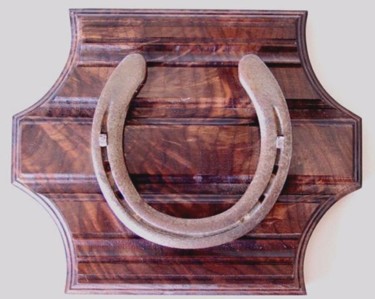Added Apr 18, 2008
Wood Box Construction & Wood Finish Techniques
Johnny has more than 20 years of experience working with wood and has worked more than 350 different species of wood. He normally keeps more than 125 species in stock.
Johnny has studied hundreds of woodworking magazine articles and more than 230 books on woodworking by as many as 190 authors. In addition he has studied numerous books and magazine articles on art, business, marketing, advertising and webmastering. He consults with both individuals and companies {World Tree Technologies, Impact Group New York, & B. K. Brown Designs} on the best wood, procedures and finishing techniques to use in the production of their wooden projects or products and how to advertise their products.
Some of Johnny's creations have been bought by or given as presents to professional people, foreign dignitaries of state, celebrities and even the President and the First Lady of the United States.
The Box Featured To The Left Is An Andiroba Gold Banded Jewelry Box. The Dimensions Are 19 1/2" L x 11 1/4" D x 5 1/4" H. The Box & Lift Out Tray Bottoms Are Lined With Red Velvet. The Middle Panal Has Ruby Red Cathedral Stained Glass & Mirror. It Has 2-24 Karat Gold Plated Cup Pulls {Shell Design} For Handles. Sold $2595.
Overall Wood Box Construction Technique
Boxes can be any creations that have three or more sides and are meant to be displayed either laying flat on a 180 degree surface or standing or hanging in a 90 degree horizontal upright position.
Johnny's wood box creations can take 175-250 separate steps or procedures from start to completion. His more intricate jewelry box creations that have partitioned trays, a musical movement, are lined with velvet, have partitioned lids with stained glass and mirror panels take over 250 separate steps or procedures to complete.
Johnny selects the wood for each and every one of his creations, based on its grain, figure patterns {reading the wood} color, and how much it moves in service {expands and contracts} with temperature & humidity changes. Lumber is checked with a moisture meter, only lumber with moisture content of 6%-12% is used. Lumber in this range is extremely stable.
Each box creation and all its wood components come from either one individual piece of wood or from woods in the same movement category thus allowing the whole unit to move the same amount. The sides of the boxes, trays and Spanish Cedar linings {cigar humidors} are cut in an order which allows the figure and grain patterns of the wood to be continuous wrapping around the perimeter of the box.
The corner joints are cut at a mitered angle appropriate to the number of sides the box creation has. 3 sided - 60 degrees, 4 sided - 45 degrees, 5 sided - 36 degrees, 6 sided - 30 degrees, 7 sided - 25.71 degrees {26 is close enough}, 8 sided - 22.5 degrees, 9 sided - 20 degrees, 10 sided - 18 degrees, 11 sided - 16.36 degrees {16 is close enough}, 12 sided - 15 degrees, 15 sided - 12 degrees, 16 sided - 11.25 degrees {11 is close enough}.
All corner joints have hidden biscuits. The shape of the biscuits differs a little from those that can be bought already made. The biscuits are cut utilizing a bandsaw from the same wood the box is made and so the grain runs across the biscuit instead of vertically {up and down} the long way. This way the grain is running the same way as the box sides and is the same as gluing two pieces of wood face to face. This technique produces an extremely strong joint!
Wood Jewelry Box Construction Technique Featuring Stained Glass & Mirror Panels
Any box creations with back to back wood and stained glass, wood and mirror glass or stained glass and mirror glass panels are done utilizing a technique, which separates the two panels with a soft cushiony type material that under normal use, absorbs the impact of any sudden jar and will keep the glass from breaking.
Wood Music Box Construction Technique
With music box creations, if the wood is left unfinished there are woods such as Mahogany, Alder and Spruce that will produce a richer sound {tone} than others. When left unfinished, harder woods will not absorb the repercussions of the notes as much as softer woods, therefore producing a fuller, louder, richer and crisper sound {tone}. When the wood is finish coated with lacquer, shellac, polyurethane, etcetera, it will cause the sound to bounce off the coating instead of the wood, so even softer woods will have a richer sound {tone}. A softer finish coating such as Tung Oil will produce a mellower sound than lacquers and shellacs. To make the sound repercussion even richer, Johnny surrounds the perimeter of the musical movement with wood, leaving the top open, so the sound is bounced off the perimeter sides {funneled} to the top and then out.
Wood Cigar Humidor Construction Technique
His cigar humidor lids, have to be slightly pressed closed the last 1/2" or so creating the swoosh effect. This indicates and insures the humidor has an airtight seal thus making the inside a fully self contained separate environment. Without the swoosh effect, all it would be is an ordinary box. This is accomplished by cutting the linings 1/2" taller to allow them to stick up inside the lid 1/2" when closed. The lid is also recessed 1/2" to allow the linings and the lid to fit together tightly.
If a cigar humidor is opened and closed {used} frequently, there will be no problem with mold. Because Johnny's humidors are a fully self contained separate environment, there is no air exchange what so ever between the outside and the inside environments. If not opened and closed {used} very much, they should be opened every two weeks or so for a couple of minutes.
Spanish Cedar, the traditional lining for humidors, is in the minute wood movement category, it does not expand and contract as much as the majority of woods do. Johnny either leaves the Spanish Cedar linings floating or he slots the linings and uses stainless steel screws to affix them so as to allow the two woods to slide along one another resulting in no damage to the humidor when it expands and contracts. To leave floating, Johnny cuts the corner joints at 45 degrees making them fit somewhat snugly. Humidors are kept at 70% humidity. Most houses and his shop are kept at 50% or less humidity. At 70% humidity, the Spanish Cedar linings will then expand a little more, thus making the linings fit even more snug.
Spanish Cedar gives off a fragrant scent, because of the oil inside which can also ooze out {sweating} of the surface and appear as a sticky resinous type substance. This is not good if it gets on the cigars. Johnny checks and makes sure that the Spanish Cedar that is used for linings that go into each of his humidors do not have the oils oozing out {sweating}.
Johnny has lined, custom made humidors with Aromatic Cedar, because the client did not want their cigars smelling like Spanish Cedar. He has also lined the entire inside of a humidor with velvet, because the client wanted their cigars to smell natural.
Whether Aromatic or Spanish Cedar wood linings are used, Johnny leaves them unfinished, because any type of coating would seal the wood thus stopping it from giving off the fragrance. Also, the finer the sandpaper used to sand the linings, the less fragrance either wood will give off.
Johnny's Technique For Better Air Circulation
From Johnny's own personal experience, if cigars are stacked more than 3 tiers high, the cigars on the bottom tier do not get as much air as the cigars on the upper tiers.
His technique does circulate the air a lot better. He makes a second bottom {false bottom}, that he drills numerous holes into. It sits on top of 3/8" slats, two that are placed on opposites sides and depending on how long the humidor is 1 - 3 in the middle. The slats are all sitting on the true bottom of the humidor thus making an airspace. Then he leaves 1/4" - 1/2" or more at both ends of the cigars. This allows air to circulate all around the stack. He uses this technique on most of his custom made to order cigar humidors.
Dear Mr. Morlan, The humidor you made for me has outstanding craftsmanship and character. I am a stickler about cigars. Mine have always been stacked 6 high in the box. I knew and could tell that the bottom 2 rows were not getting that much air so I have always rotated my cigars. Your technique for air circulation works great! Larry H - Bethesda, Maryland
Wood Finish Technique
There are numerous techniques and finishes for finishing wood, a true wood artist develops their own techniques and finish to bring out the beauty of their works.
Johnny's technique for finishing wood {small pieces that are not handled or used a lot} is not to fill the pores, thus showcasing the intricacy of his designs and the natural character, distinction and depth of the wood making each piece one of a kind, just like your own fingerprint does for you.
Wood is such a beautiful medium to work with he does not wish to hide its natural beauty by utilizing numerous coats of lacquer, shellac, polyurethane, and etcetera. He handcoats and rubs in the first coat, then adds two more handcoated topcoats using a clear marine grade polyurethane spar varnish that is impervious to most liquids including body oils and some mild acids. It also has ultraviolet inhibitors in it to repel the suns UV rays. Johnny adds a couple of other ingredients to make it easier to apply and be worked into the wood with a cloth thus allowing the finish to penetrate the wood but not thick enough to take away the three dimensional look of the surface or giving an effect of looking like a piece of plastic.


